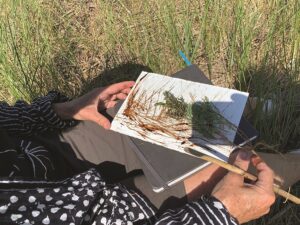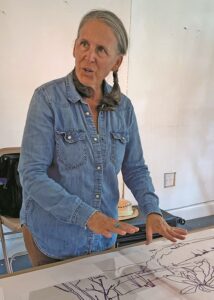TRURO — On a reed-covered stretch of sand jutting out into Pamet Harbor, five students and their instructor dip their natural brushes — a broken-in-half reed, a corner of a bone, and a dangling sea asparagus — into walnut ink before bringing the brushes to their sketchbooks. They draw the natural environment, turning the swirling ink into scenes of swaying grasses and wispy clouds.

The instructor, Amy Wynne, is an artist from Pawtucket, R.I. who specializes in integrating mindfulness and creative practice. She looks over her students’ shoulders, reminding them to pay attention to the smells washing over them and offering them different objects from the earth that they could use as painting tools.
“You’re drawing the thing with the thing,” she says, as student Becky MacDonald of Brooklyn streaks an ink-splattered sea asparagus across her page, imitating the wind-whirled reeds.
The class, called Re-Wilding: Embodying the Natural World through Drawing & Meditation, was advertised as a way to witness “the beauty of the natural world” as a “gateway to authentic inspiration.” Re-Wilding was offered by the Truro Center for the Arts at Castle Hill, a community art center that has hosted a range of workshops since 1971.

Wynne, a graduate of the New York Academy of Art and a painting instructor for over 25 years, has been teaching at Castle Hill for more than a decade. She says that most of her previous workshops were focused on painting fundamentals, while this class’s emphasis on mindfulness is a new and exciting exploration for her. Wynne says more and more of her art classes are “incorporating mindfulness practice,” and that this enhances the experience of her students and her own journey as an artist. “I love getting people outside, re-wilding to just be healed and inspired by nature,” she says.
Wynne says she designed the course to help her students experience and care for the natural environment of the Outer Cape, a place she has seen as her second home since she was a child. Her grandfather retired in Truro in the 1950s, and Wynne spent her childhood summers and a number of years in the ’90s living here.
“Mary Oliver said, ‘Attention is the beginning of devotion,’ ” says Wynne. “And I really believe that. If we can find vehicles like meditation and moving slowly through nature and drawing and painting as vehicles to interpret and experience our surroundings in a mindful way, that’s the key to what the world really needs right now.”

After drawing with ink on one side of Pamet Harbor, the class walks to the other side, over to Old Pamet Road, and begins an activity Wynne calls “Translucent vs. Transparent.” The class uses Sharpies on see-through acetate paper to draw what they see around them. Wynne tells the class to first draw the big picture, the view of the river dotted with boats, and then to turn toward the micro, the smooth pebble in the center of the path. The students stare out into the distance or lean bent over a beetle, sketching whatever has captured their attention.
After 30 minutes of drawing, the students put away their Sharpies and head over to Castle Hill’s Edgewood Farm campus for the last hour of class. There they take out their sketches of the Pamet. Wynne instructs the students to overlay and overlap the see-through pages, creating mesmerizing tapestries. “We’re rearranging memory,” she says. “Who’s to say what came first or last?” The students sit at their own tables rearranging their drawings, finding interlocking lines in the images, using each individual aspect to create the feeling of the landscape, to recreate, Wynne says, “the memory of moving through that space.”
The emphasis of the workshop is not perfection but rather experimentation. Wynne says, “There is no right or wrong; we’re just trying to be playful.” The class includes both beginners and more experienced artists, but all agree they feel liberated by this lighheartedness. Nadia Veliz, a visitor from New York City, says, “It’s so easy when you do art classes in school or in a formal setting to feel like you have to do everything correctly and there’s a loss of self in that. A class like this where you get to go at it without that sort of stress is so important.”

Patti Gibson from Chatham agrees that the class helped her not only to improve as an artist but also to slow down and see the beauty of this place. “The class made me realize that we’re so used to doing things quickly, with momentum, and when you do things slowly, it’s harder,” she says, adding, “But then you get to enjoy the beautiful flowers, the trees, the sky — you just get to take it all in.”
Wynne says she hopes her students take away the knowledge that there are endless ways to create art and find connection with the ever-passing present.
“These practices are a catalyst for awakening, for connecting, for appreciating the fleeting beauty that’s all around us,” she says.
Time flies — it’s five o’clock already. The students pack away their interlaced landscapes, their pens disappear into backpacks, and they head out the door and into the wild.
